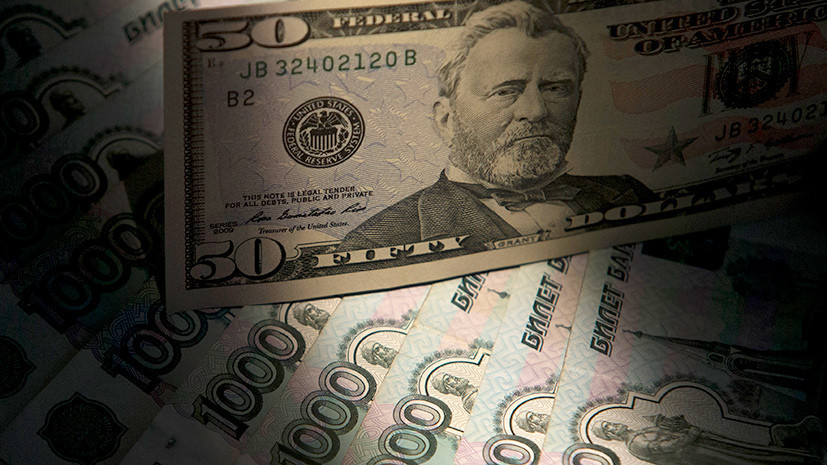On Thursday, October 17, at the Moscow Exchange, Russian currency confidently strengthens against the US and slightly weakens against the European one. The US dollar depreciated by 0.3%, to 63.86 rubles. The last time a similar value could be observed on September 24. The euro exchange rate increased by 0.19% to 71.1 rubles.
The official exchange rate of the Central Bank on October 18 was 64.0144 rubles per dollar and 70.9023 rubles per euro.
“The ruble now has several support factors. The most important is the overall growth in the assets market of developing countries. The dynamics changed dramatically after the US and China made progress in trade negotiations. Thus, investors had the hope that in the foreseeable future at least a temporary compromise in the trade war between the two countries would be reached, ”Ivan Kapustyansky, a leading Forex Optimum analyst, explained in an interview with RT.
Following the talks in October, China and the United States were able to partially agree on the terms of the deal. As stated by Donald Trump after a meeting with Chinese representatives, the parties reached an agreement on the protection of intellectual property and the financial sector. In addition, Beijing also agreed to increase purchases of US agricultural products.
In addition to success in US-China trade negotiations, the ruble is also supported by high demand for federal loan bonds (OFZ) from foreign investors and the upcoming tax period. At this time, traditionally, exporting companies begin to sell foreign currency and buy rubles for taxes.
“The peak of the tax period will fall on October 25-28. Corporations will approximately sell about $ 25 billion. In fact, the process of buying rubles has already begun. Moreover, additional demand for the ruble is also presented by non-residents who seek to buy OFZs with still high returns. In particular, this is evidenced by the government bond index (RGBI), which is trading at historic highs - near 147.5 points, ”Kapustyansky added.
It is curious that the ruble managed to appreciably strengthen against the dollar with falling oil prices. According to the ICE exchange in London, at the September 17 auction, the cost of raw materials of the Brent benchmark brand fell by 0.5% to $ 59 per barrel. According to experts, in recent months, investors in the Russian foreign exchange market have become less responsive to fluctuations in commodity prices.
“It is worth noting that the recent fluctuations in the oil market did not affect the ruble exchange rate in any way, since they were temporary and did not lead to a change in the trend. Recently, investors have become more cautious when comparing the dynamics of oil and the ruble, ”Ilya Grigoriev, debt market analyst at Ivolga Capital, explained in an interview with RT.
A slight weakening of the ruble against the euro is taking place against the backdrop of the global appreciation of the single European currency against the US dollar. During the auction on October 17, the corresponding rate increased by 0.5% and reached its maximum level in two months - $ 1.11 per euro.
Investors reacted positively to the news about the Brexit deal between London and the EU. As European Commission President Jean-Claude Juncker said on October 17, the parties were able to agree on the conditions for the kingdom to leave the union. Now the agreement should be approved by the European Council and the British Parliament.
“When there is a will, there is a deal - we have it! This is a fair and balanced agreement for the EU and the United Kingdom. It shows our commitment to finding solutions. I recommend the European Council to approve this deal, ”Juncker wrote on his Twitter.
Pressure on the dollar
The strengthening of the Russian currency against American analysts is also associated with a noticeable weakening of the dollar on the world market. So, as early as September 30, the corresponding DXY index was near a three-year high and reached the level of 99.7 points. Meanwhile, now the figure has already dropped to the level of the end of August - 97.6 points.
One of the main reasons for the weakening dollar, experts believe the actions of the US Federal Reserve. Over the past month, the Federal Reserve additionally printed and poured about $ 185 billion into the US economy. Moreover, until the middle of 2020, the regulator plans to pump another $ 510 billion into the financial system.
The Fed began to actively print new dollars after the recent liquidity crisis, when in mid-September, US banks were faced with a shortage of free money. An increase in the money supply in the financial system should help lending institutions, but may increase inflation and put pressure on the dollar. Moreover, the actions of the Federal Reserve reinforce investors' concerns about the imminent start of a recession in the United States.
“With the advent of information about a possible recession in the States, market players have only now been able to assess potential losses. The actions taken by the Federal Reserve allow delaying the recession by increasing the money supply, but the economic slowdown that has begun cannot be eliminated by such actions, ”Andrei Lyushin, deputy chairman of the board of Loko-Bank CB, explained in an interview with RT.
According to Ivan Kapustyansky, in the near future the Russian currency has a chance to further strengthen against the American one. According to experts, the dollar may fall to 63.5 rubles and below. At the same time, the euro exchange rate can grow to 72 rubles in the short term, after which it will move to around 70 rubles.

